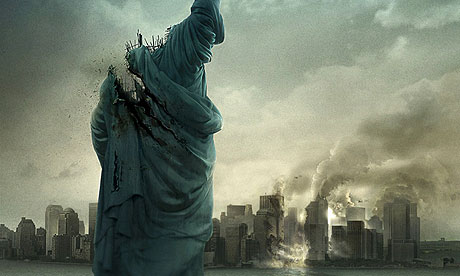
Because the monster-trashes-New-York film, produced by Lost creator JJ Abrams, is causing motion sickness and migraine in some viewers.
I'm one of them: I had to flee about half an hour into the film, suffering intense nausea and the beginnings of a vicious migraine that didn't let up until lunchtime the following day.
I'm not the only one. When the film opened in the US, newspapers quickly began reporting that it was making people feel sick. The Los Angeles Times noted last month that "reports of illness while watching Cloverfield started popping up on internet bulletin boards over the weekend, with some people writing that they had to leave a few minutes into the movie. One poster reported vomiting several times."
Migraine too was reported in the US, with comments such as "the film is dizzying, irritating and unbearable. I had a migraine halfway through" and "what I got from Cloverfield was a migraine because the damn camera wouldn't stay still" (tinyurl.com/ysh7w6).
So what is happening? The problem is that the movie is made in the style of an amateur using a handheld camera. No shot holds still for more than a second or two, an effect which, when projected on to a big screen, is very likely to cause nausea, and, in the susceptible, migraine.
Steven Galetta, director of neuroopththalmology at the University of Pennsylvania Medical Center, explained to the Philadelphia Inquirer that the sense of balance, which depends on the inner ear's vestibular system, is being confused by this technique. Sharp camera movements - such as those you find in the wobblecam sequences that make up Cloverfield - can lead to nausea. "I got sick watching the trailer," he said. "I'm not going to see the movie."
The Migraine Action Association here in the UK wasn't surprised that I'd had a migraine. It says: "A susceptible person may have a migraine triggered because of bright or flashing lights," - of which there are many in Cloverfield - and "loud noise", of which there is lots in the film. Lee Tomkins, director of the charity, adds: "Problems are exacerbated where filming techniques involve exaggerated movements where films pan in or out or where the filming uses handheld techniques, or uses a variety of different light settings: flicking from dark to light is a common trigger."
However, Paramount, the distributor of the film, should have been aware of the potential for trouble. The Blair Witch project, which also used handheld cameras throughout, had much the same effect on moviegoers. As Paramount didn't return our calls, we can only assume that it is working on the principle that the publicity will be good for its box office takings.
· More on Cloverfield

